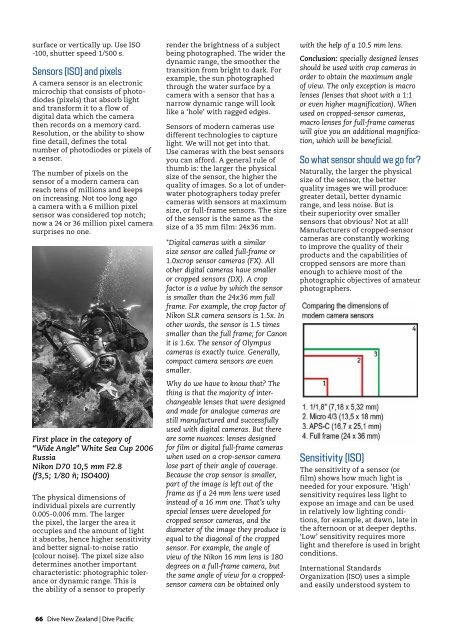Dive Pacific Iss 171 Oct- Nov 2019
New Zealand's dive magazine featuring in this issue: Shooting big sharks, up close; Spearfishing at night!; Remembering a great Kiwi dive pioneer, Wade Doak; Forgotten Vanuatu wreck's claim to fame; The invasive Lionfish - in depth, plus all our expert columnists
New Zealand's dive magazine featuring in this issue: Shooting big sharks, up close; Spearfishing at night!; Remembering a great Kiwi dive pioneer, Wade Doak; Forgotten Vanuatu wreck's claim to fame; The invasive Lionfish - in depth, plus all our expert columnists
You also want an ePaper? Increase the reach of your titles
YUMPU automatically turns print PDFs into web optimized ePapers that Google loves.
surface or vertically up. Use ISO<br />
-100, shutter speed 1/500 s.<br />
Sensors (ISO) and pixels<br />
A camera sensor is an electronic<br />
microchip that consists of photodiodes<br />
(pixels) that absorb light<br />
and transform it to a flow of<br />
digital data which the camera<br />
then records on a memory card.<br />
Resolution, or the ability to show<br />
fine detail, defines the total<br />
number of photodiodes or pixels of<br />
a sensor.<br />
The number of pixels on the<br />
sensor of a modern camera can<br />
reach tens of millions and keeps<br />
on increasing. Not too long ago<br />
a camera with a 6 million pixel<br />
sensor was considered top notch;<br />
now a 24 or 36 million pixel camera<br />
surprises no one.<br />
First place in the category of<br />
“Wide Angle” White Sea Cup 2006<br />
Russia<br />
Nikon D70 10,5 mm F2.8<br />
(f3,5; 1/80 ñ; ISO400)<br />
The physical dimensions of<br />
individual pixels are currently<br />
0.005-0.006 mm. The larger<br />
the pixel, the larger the area it<br />
occupies and the amount of light<br />
it absorbs, hence higher sensitivity<br />
and better signal-to-noise ratio<br />
(colour noise). The pixel size also<br />
determines another important<br />
characteristic: photographic tolerance<br />
or dynamic range. This is<br />
the ability of a sensor to properly<br />
render the brightness of a subject<br />
being photographed. The wider the<br />
dynamic range, the smoother the<br />
transition from bright to dark. For<br />
example, the sun photographed<br />
through the water surface by a<br />
camera with a sensor that has a<br />
narrow dynamic range will look<br />
like a ‘hole’ with ragged edges.<br />
Sensors of modern cameras use<br />
different technologies to capture<br />
light. We will not get into that.<br />
Use cameras with the best sensors<br />
you can afford. A general rule of<br />
thumb is: the larger the physical<br />
size of the sensor, the higher the<br />
quality of images. So a lot of underwater<br />
photographers today prefer<br />
cameras with sensors at maximum<br />
size, or full-frame sensors. The size<br />
of the sensor is the same as the<br />
size of a 35 mm film: 24x36 mm.<br />
*Digital cameras with a similar<br />
size sensor are called full-frame or<br />
1.0xcrop sensor cameras (FX). All<br />
other digital cameras have smaller<br />
or cropped sensors (DX). A crop<br />
factor is a value by which the sensor<br />
is smaller than the 24x36 mm full<br />
frame. For example, the crop factor of<br />
Nikon SLR camera sensors is 1.5x. In<br />
other words, the sensor is 1.5 times<br />
smaller than the full frame; for Canon<br />
it is 1.6x. The sensor of Olympus<br />
cameras is exactly twice. Generally,<br />
compact camera sensors are even<br />
smaller.<br />
Why do we have to know that? The<br />
thing is that the majority of interchangeable<br />
lenses that were designed<br />
and made for analogue cameras are<br />
still manufactured and successfully<br />
used with digital cameras. But there<br />
are some nuances: lenses designed<br />
for film or digital full-frame cameras<br />
when used on a crop-sensor camera<br />
lose part of their angle of coverage.<br />
Because the crop sensor is smaller,<br />
part of the image is left out of the<br />
frame as if a 24 mm lens were used<br />
instead of a 16 mm one. That’s why<br />
special lenses were developed for<br />
cropped sensor cameras, and the<br />
diameter of the image they produce is<br />
equal to the diagonal of the cropped<br />
sensor. For example, the angle of<br />
view of the Nikon 16 mm lens is 180<br />
degrees on a full-frame camera, but<br />
the same angle of view for a croppedsensor<br />
camera can be obtained only<br />
with the help of a 10.5 mm lens.<br />
Conclusion: specially designed lenses<br />
should be used with crop cameras in<br />
order to obtain the maximum angle<br />
of view. The only exception is macro<br />
lenses (lenses that shoot with a 1:1<br />
or even higher magnification). When<br />
used on cropped-sensor cameras,<br />
macro lenses for full-frame cameras<br />
will give you an additional magnification,<br />
which will be beneficial.<br />
So what sensor should we go for?<br />
Naturally, the larger the physical<br />
size of the sensor, the better<br />
quality images we will produce:<br />
greater detail, better dynamic<br />
range, and less noise. But is<br />
their superiority over smaller<br />
sensors that obvious? Not at all!<br />
Manufacturers of cropped-sensor<br />
cameras are constantly working<br />
to improve the quality of their<br />
products and the capabilities of<br />
cropped sensors are more than<br />
enough to achieve most of the<br />
photographic objectives of amateur<br />
photographers.<br />
Sensitivity (ISO)<br />
The sensitivity of a sensor (or<br />
film) shows how much light is<br />
needed for your exposure. ‘High’<br />
sensitivity requires less light to<br />
expose an image and can be used<br />
in relatively low lighting conditions,<br />
for example, at dawn, late in<br />
the afternoon or at deeper depths.<br />
‘Low’ sensitivity requires more<br />
light and therefore is used in bright<br />
conditions.<br />
International Standards<br />
Organization (ISO) uses a simple<br />
and easily understood system to<br />
66 <strong>Dive</strong> New Zealand | <strong>Dive</strong> <strong>Pacific</strong>













